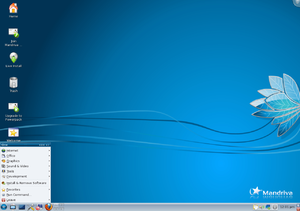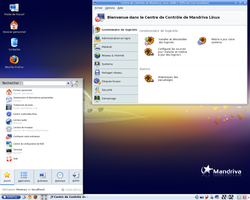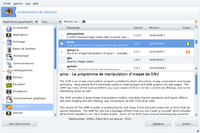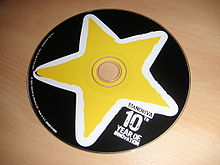| LinuxPlace.net the Linux Place on the Net |
Mandriva Linux
By Wikipedia, the free encyclopedia
http://en.wikipedia.org/wiki/Mandriva_Linux
Mandriva Linux (result of fusion of the French distribution Mandrakelinux or Mandrake Linux and the Brazilian distribution Conectiva Linux) is a Linux distribution distributed by Mandriva . It uses the RPM Package Manager. The product lifetime of Mandriva Linux releases is 18 months for base updates (Linux, system software, etc.) and 12 months for desktop updates (window managers, desktop environments, web browsers, etc.). Server products receive full updates for at least 5 years after their release.
History
The first release was based on Red Hat Linux (version 5.1) and K Desktop Environment 1 in July 1998. It has since moved away from Red Hat's distribution and has become a completely separate distribution in its own right. Mandriva now includes a number of original tools, mostly to ease system configuration. Mandriva Linux was the brainchild of Gaël Duval, who wanted to focus on ease of use for new users. Duval became the co-founder of Mandrakesoft, but was laid off from the company in 2006 along with many other employees. Later Duval announced to NewsForge that he was going to bring suit against Mandriva for "abusive layoff". On May 8, 2010, Mandriva announced that due to financial distress, the company was up for sale.
On September 18, 2010, due to financial uncertainty and the layoff by Edge-IT, a Mandriva subsidiary employing many of the corporate staff working on the Mandriva distribution, a fork of Mandriva named Mageia was announced.
Name changes
From its inception until the release of version 8.0, Mandrake named its flagship distribution Linux-Mandrake. From version 8.1 to 9.2 the distribution name was reversed and called Mandrake Linux.
In February 2004 MandrakeSoft lost a court case against Hearst Corporation, owners of King Features Syndicate. Hearst contended that MandrakeSoft infringed upon King Features' trademarked character Mandrake the Magician. As a precaution, MandrakeSoft renamed its products by removing the space between the brand name and the product name and changing the first letter of the product name to lower case, thus creating one word. Starting from version 10.0, Mandrake Linux became known as Mandrakelinux, and its logo changed accordingly. Similarly, MandrakeMove became Mandrakemove.
In April 2005 Mandrakesoft announced the corporate acquisition of Conectiva, a Brazilian based company that produced a Linux distribution for Portuguese-speaking (Brazil) and Spanish-speaking Latin America. As a result of this acquisition and the legal dispute with Hearst Corporation, Mandrakesoft announced that the company was changing its name to Mandriva, and that their linux distribution Mandrake Linux would henceforward be know as Mandriva Linux.
Features
The major features of Mandriva Linux are:
Installation, control and administration
Mandriva Linux contains the Mandriva Control Center, which eases configuration of some settings. It has many programs known as Drakes or Draks, collectively named drakxtools, to configure many different settings. Examples include MouseDrake to set up a mouse, DiskDrake to set up disk partitions and drakconnect to set up a network connection. They are written using GTK+ and Perl, and most of them can run in both graphical and text mode using the ncurses interface.
Desktops
The latest version of Mandriva Linux, 2011.0 officially supports only KDE Plasma Desktop, whereas other desktop environments are available but not supported. Older Mandriva versions used Plasma Desktop as standard but others such as GNOME were also officially supported.
Themes
A unique theme provides consistency between applications and desktop environments. Galaxy debuted in version 9.1 and Galaxy II appeared in 10.0. A variant of Galaxy is "Galaxy Squared", which uses square window buttons rather than round ones. A new default theme named "Ia Ora" was introduced with the release of Mandriva Linux 2007, but "Galaxy" remains available as an option for those who prefer it.
Package manager
Mandriva Linux uses a package manager called urpmi, which functions as a wrapper to the RPM package management system. It is similar to apt-get or Yellow dog Updater, Modified in that it allows seamless installation of a given software package by automatically installing the other packages needed. It is also media-transparent due to its ability to retrieve packages from various media, including network/Internet, CD/DVD and local disk. Urpmi also has an easy-to-use graphical front-end called rpmdrake, which is integrated into the Mandriva Control Center.
Remote sources for urpmi / rpmdrake can be added during the installation of recent Mandriva Linux versions. After installation, they can be added through an option in the Software Sources Manager, or by using console commands generated either manually or by one of several helper sites such as Easy URPMI. This functionality allows the user to choose some or all of the various software repositories available for their version of Mandriva Linux and can greatly expand the amount of software that the user can install through the urpmi system. Instructions on adding repositories and installing software can be found on the Mandriva Wiki.
Live USB
A Live USB of Mandriva Linux can be created manually or with UNetbootin.
Availability
Mandriva provides multiple editions of Linux. Some are freely-distributable, while others are sold online and via a network of authorized resellers.
Versions
Since 2007, Mandriva is released on a 6-month fixed-release cycle, similar to Ubuntu and Fedora. In 2011 the release model was changed towards a yearly cycle.
Latest version
The latest stable version is Mandriva Linux 2011 ("Hydrogen"). It was released on August 28, 2011.
Development version
The development tree of Mandriva Linux has always been known as Cooker. This tree is directly released as a new stable version.
Other Systems
Many Operating Systems like Mandriva include Ubuntu, Fedora and many more, each filled with many features.
Table of versions
| Year | Number | Name |
|---|---|---|
| 1998 | 5.1 | Venice |
| 1998 | 5.2 | Leeloo |
| 1999 | 5.3 | Festen |
| 1999 | 6.0 | Venus |
| 1999 | 6.1 | Helios |
| 2000 | 7.0 | Air |
| 2000 | 7.1 | Helium |
| 2000 | 7.2 | Odyssey (called Ulysses during beta) |
| 2001 | 8.0 | Traktopel |
| 2001 | 8.1 | Vitamin |
| 2002 | 8.2 | Bluebird |
| 2002 | 9.0 | Dolphin |
| 2003 | 9.1 | Bamboo |
| 2003 | 9.2 | FiveStar |
| 2004 | 10.0 | Community and Official |
| 2004 | 10.1 | Community |
| 2004 | 10.1 | Official |
| 2005 | 10.2 | Limited Edition 2005 |
| 2005 | 2006.0 | Mandriva Linux 2006 |
| 2006 | 2007 | Mandriva Linux 2007 |
| 2007 | 2007.1 | Mandriva Linux 2007 Spring |
| 2007 | 2008.0 | Mandriva Linux 2008 |
| 2008 | 2008.1 | Mandriva Linux 2008 Spring |
| 2008 | 2009.0 | Mandriva Linux 2009 |
| 2009 | 2009.1 | Mandriva Linux 2009 Spring |
| 2009 | 2010.0 | Mandriva Linux 2010 |
| 2010 | 2010.1 | Mandriva Linux 2010 Spring |
| 2010 | 2010.2 | Mandriva Linux 2010.2 |
| 2011 | 2011 | Hydrogen |
Editions
Each release of Mandriva Linux is split into several different editions. Each edition is derived from the same master tree, most of which is available on the public mirrors: all free / open source software, and all non-free software which is under a license that allows unrestricted distribution to the general public, is available from the public mirrors. Only commercial software under a license that does not allow unrestricted distribution to the general public (but for which Mandriva has negotiated an agreement to distribute it with paid copies) is not available from public mirrors.
Current
Mandriva Linux Free
Mandriva Linux Free is a 'traditional' distribution (i.e. one that comes with a dedicated installer, named DrakX, which is first used to install the distribution to the hard disk of the computer before it is run). It is 'free' in both senses: it consists entirely of free and open-source software, and it is made available for public download at no charge. It is usually available in CD (three or four discs) and DVD editions for x86 32- and 64-bit CPU architectures. It is aimed at users to whom software freedom is important, and also at users who prefer a traditional installer to the installable live CD system used by One. The package selection is tailored towards regular desktop use. It consists of a subset of packages from the 'main' and 'contrib' sections of the master tree.
Mandriva Linux One
Mandriva Linux One is free to download. It is a hybrid, being both a Live CD and an installer (with an installation wizard that includes disk partitioning tools).
Several Mandriva Linux One versions were provided for each Mandriva Linux release preceding Mandriva 2008. Users could choose between different languages, select either the KDE or GNOME desktops and include or exclude non-free (as in speech) software. (It is not possible to fit both KDE and GNOME desktops, or more than a few languages, on a single live CD.) The 'lead' version is the KDE version with non-free software included. The One images consist of a subset of packages from the 'main', 'contrib' and 'non-free' sections of the master tree, with the documentation files stripped from the packages to save space.
Mandriva Linux One 2008 has a smaller range of versions. There are KDE and GNOME versions with the default set of languages. There are also two KDE versions with alternative sets of languages. All versions include non-free software.
Mandriva Linux Powerpack
Mandriva Linux Powerpack is a 'traditional' distribution (in other words, one that comes with a dedicated installer, DrakX, which is first used to install the distribution to the hard disk of the computer before it is run). It is the main commercial edition of Mandriva Linux, and as such, requires payment for its use. It contains several non-free packages intended to add value for the end user, including non-free drivers like the NVIDIA and ATI graphics card drivers, non-free firmware for wireless chips and modems, some browser plugins such as Java and Flash, and some full applications such as Cedega, Adobe Reader and RealPlayer. It is sold directly from the Mandriva Store website and through authorized resellers. It is also made available via a subscription service, which allows unlimited downloads of Powerpack editions for the last few Mandriva releases for a set yearly fee. It consists of a subset of packages from the 'main', 'contrib', 'non-free' and 'restricted' sections of the master tree.
In Mandriva Linux 2008, the Discovery and Powerpack+ editions have been merged into Powerpack, which will become Mandriva's only commercial offering. Users will be able to choose between a novice-friendly Discovery-like setup or an installation process and desktop aimed at power users.
Discontinued
Mandriva Linux Discovery
Mandriva Linux Discovery was a commercial distribution aimed at first-time and novice Linux users. It was sold via the Mandriva Store website and authorized resellers, or could be downloaded by some subscribers to the Mandriva Club. Mandriva Linux 2008 does not include a Discovery edition, having added optional novice-friendly features to the Powerpack edition.
In releases prior to Mandriva Linux 2007, Discovery was a 'traditional' distribution built on the DrakX installer. In Mandriva Linux 2007 and 2007 Spring, Discovery is a hybrid "Live DVD" which can be booted without installation or installed to hard disk in the traditional manner.
Discovery was a DVD rather than a CD, allowing all languages to be provided on one disc. It consisted of a subset of packages from the 'main', 'contrib', 'non-free' and 'non-free-restricted' sections of the master tree. The package selection was tailored towards novice desktop users. A theme chosen to be appealing to novice users was used, and the 'simplified' menu layout in which applications are described rather than named and not all applications are included was the default (for all other editions, the default menu layout was the 'traditional' layout, where all graphical applications installed on the system were included and were listed by name).
Mandriva Linux Powerpack+
Mandriva Linux Powerpack+ was a version of Powerpack with additional packages, mostly commercial software. Like Powerpack, it was sold directly from the Mandriva Store website and through authorized resellers; it was also a free download for Mandriva Club members of the Gold level and above. Powerpack+ was aimed at SOHO (small office / home office) users, with the expectation that it could be used to run a small home or office server machine as well as desktop and development workstations. The package selection was tailored with this in mind, including a wide range of server packages. It consisted of a subset of packages from the 'main', 'contrib', 'non-free' and 'restricted' sections of the master tree.
Mandriva 2008 no longer includes a Powerpack+ edition; instead, the Powerpack edition includes all the available packages.
Derivatives
Derivatives are distributions that are based on Mandriva Linux, some by Mandriva itself, others by independent projects. Some maintain compatibility with Mandriva Linux, so that installing a Mandriva Linux RPM also works on the offspring.
Current
Mandriva Flash
Mandriva Flash is a pre-installed Mandriva Linux distribution on a 8 GB USB key. The user can choose how much space is used for system files and how much is reserved for user files. An earlier version of Mandriva Flash was 4 GB and before that 2 GB in size with fixed ratios. It can be booted directly from the key on systems that support booting from USB devices, or from a 'kickstart' CD (the image for the CD is provided with the Flash) on systems that do not. Flash runs faster than live CDs due to the relative speed of flash memory, and the read/write nature of the medium allows users to save files, configuration options and even to install new packages.
Mandriva Corporate Server
Mandriva Corporate Server is a distribution specifically tailored for enterprise-level general purpose server usage. Development is started from the basis of a previous Mandriva Linux release, with the package selection altered, important packages updated, certain extra configuration tools and applications added, and some extra support for enterprise-level hardware. The maintenance lifetime of each release is five years. The current release of Corporate Server is 4.0.
Mandriva Corporate Desktop
Mandriva Corporate Desktop is the desktop counterpart to Corporate Server. Again it is based on a Mandriva Linux release with enterprise-specific modifications and a five-year maintenance lifetime. The current release of Corporate Desktop is 4.0.
Discontinued
Multi Network Firewall
Linux Mandrake 7.2 had a version tailored specifically for use as a firewall, known as Single Network Firewall (SNF). Its successor, based on Mandrake 8.2, was titled Multi Network Firewall (MNF). The third iteration is named MNF 2 and is based upon Mandrakelinux 10.0.
These firewall distributions are designed to provide security for computer networks, and can be administered remotely via a browser-based interface or Secure Shell. MNF 2 is now counted as part of the Corporate product line and can only be bought, with support, from Mandriva.
GlobeTrotter
GlobeTrotter is a LaCie mobile USB drive loaded with a specific version of Mandriva Linux. Like Move, it can boot most PCs into Linux without installing first. The 40 GB hard drive makes it a convenient way to carry a Linux workstation around. GlobeTrotter was launched in August 2003 and could be ordered through Mandriva's online store.
Gaming Edition
Mandrake Linux 8.1 had a Gaming Edition, which was a game oriented Linux distribution. It had a port of The Sims using the Transgaming WineX technology.
CLIC
CLIC (aka Cluster LInux pour le Calcul) is a dedicated version of Mandrakelinux created by MandrakeSoft specifically for clustering environments. It was sponsored by the RNTL, other partners were ID-IMAG, Groupe Bull and Mandrakesoft. This project's aim was to produce a HPC Linux Distribution for 32- and 64-bit processors.
The objective of project CLIC was to allow the realization of large scientific computers while being based on free software. The objective consists of the realization a Linux distribution for clusters of machines, meeting the needs for deployment, administration and programming of clusters within the framework of exploitation for intensive calculation.
It features an automated installation of a full cluster using the Ka tools, urpmi and the clusterscripts.
This project was finished on 1 December 2003 and Mandrakesoft decided to continue that project with a product called Mandrake Linux Clustering. This product included Drakcluster (GUI) for improved usability. It was dedicated to the HPC market but it could also be used (with some modifications) to all kinds of clusters (such as High Availability, applicative or grid). It features parallel commands (bash, copying tools), deployment (disks), software upgrade/downgrade (urpmi parallel), monitoring (ganglia), etc. Clustering was available on x86 and x86-64 architectures.
Mandrake Move
A LiveMove is the set formed by a Live CD and a bootfloppy or USB flash drive.
Mandrake Move was a Mandriva product that benefits from a Mandrake Linux Live CD which doesn't need to be installed to run on a computer, and a USB key that automatically records bootloader, hardware configuration and personal data.
The first version of Mandrake Move was released in December 2003 (but only distributed to customers in January 2004, due to production delays). It brought two main innovations compared to competitors:
- ability to eject the cdrom if the machine has 256 MB of RAM or more (Knoppix also can, but needs to copy the whole cdrom into RAM, therefore needs a machine with 1 GB of RAM or more), and continue to operate in a "downgraded" mode allowing only to play multimedia files
- transparent save of any user modification of his/her own files and system configuration files, if operated with a USB key
The second version, now simply called Move, was released in October 2004. Hardware support and stability have seen much improvement. Move is now superseded by Mandriva One and Mandriva Flash.
Source: http://en.wikipedia.org/wiki/Mandriva_Linux
Published - October 2011
Read all articles at the Linux Place!
All rights reserved © 2011-2024 LinuxPlace.net



